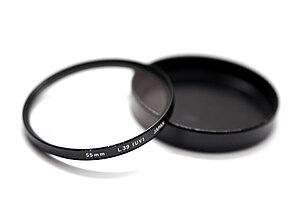UV filter
It has been suggested that this article be merged into Photographic filter. (Discuss) Proposed since January 2014. |


UV filters are individual compounds or mixtures to prevent ultraviolet (UV) light from getting through. UV filters are used in sunscreens to protect skin or in photography to reduce the level of ultraviolet light that strikes the recording medium.
Historically, photographic films were mostly sensitive to UV light, which caused haziness or fogginess, and in color films a bluish hue. Therefore, as a standard, a UV (blocking) filter was used, transparent to visible light while filtering out shorter ultraviolet wavelengths. However, newer photographic film and digital cameras are highly insensitive to UV wavelengths. UV filters are sometimes referred to as L37 or L39 filters, depending on the wavelengths of light that they filter out; an L37 filter removes ultraviolet light with a wavelength shorter than 370 nm, whereas an L39 filter eliminates light with a wavelength shorter than 390 nm.
UV filters span the color spectrum and are used for a wide variety of applications. Ortho Red and Deep Ortho Red lights are commonly used in diffusion transfer, typesetting films/paper other applications dealing with orthochromatic materials. Yellow Gold, Yellow, Lithostar Yellow and Fuji Yellow filters or safelights provide safe workspaces for contact proofing applications like screen printing and platemaking. Pan Green, Infrared Green and Dark Green filters or safelights are commonly used in scanning applications, work with panchromatic film and papers and x-rays.[1]
Many photographers and cinematographers still use UV filters as a protection for their lenses' glass and coating, due to their low cost and lack of effect on the exposure of the shot. However, UV filters (in particular filters lacking optical coating) may introduce lens flare and have an adverse impact on contrast and sharpness, especially when a strong light source is present.[2]
However, in photography, the term "UV filter" can be also be misused as a filter that passes UV light while blocking other wavelengths in the light spectrum, in the same way the term "IR filter" is also sometimes misused. The correct names for such filters though, are "UV pass filter" and "IR pass filter". This is a very specialized area in photography.
See also
References
- ^ http://www.encapsulite.com/chart.html
- ^ Thom Hogan. "Filtration 101". bythom.com. Retrieved 13 October 2009.
